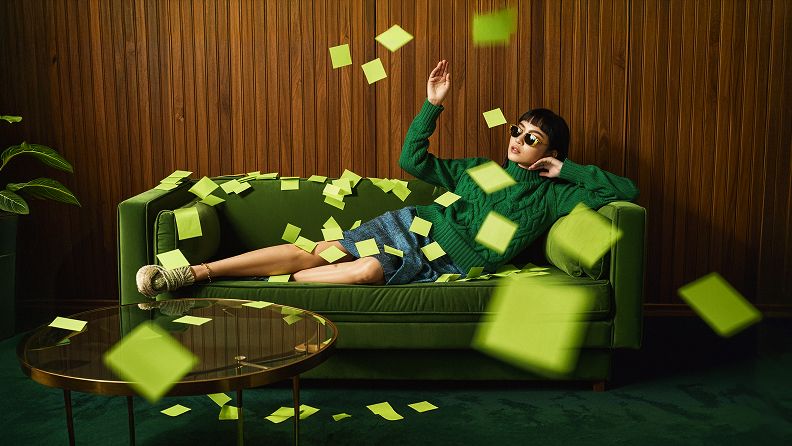Creative Collaboration: Bridging the Gap Between Marketing & Design Teams


Creative collaboration isn’t always easy. While marketers and designers share similar DNA, they need to think and feel differently to do their jobs well. Yet aligning their goals, objectives and visions is critical for delivering industry shaking, lead-generating campaigns.
So, how can these teams work better together?
In this guide, I’ll outline four core dysfunctions that arise between marketing and design teams. I’ll also dive into how marketers and designers at leading companies are solving these issues and achieving better creative collaboration. From Intercom to Meltwater, our experts dished the goods.
NOTE: This is an abbreviated version of our full Design Dysfunctions Guide. Enjoy this preview and be sure to download the full guide for a more in-depth analysis, including expert interviews, videos and case studies.
Discover the top four issues with creative collaboration and how to solve them:
Creative Collaboration Issue #1: Design and Creative Teams Are Treated Like a Drive-Thru
It’s not that designers want to hand in work late or off-brief, but often design team structure leads to “service-based design” where their only function is to pump out creative assets.
How a design team functions and its role within an organization can lead to:
- Delays and missed deadlines
- Misalignment of priorities
- Wasted time creating the wrong work
This was one of the most oft-cited and significant issues in the audience-specific survey we ran on the topic. So, here are a few solutions to help you organize your team for success (professionally and mentally):
1. Make creative teams partners in success
Make sure design isn’t an afterthought by bringing creative teams into projects, especially strategic ones, at the right time. How can teams decide when to involve designers in a given project or campaign? Goal-setting is a good place to start.
“A lot of challenges come when marketing has very vague goals that don't have any clear design dependencies. You may want to drive three million in sales this quarter, but how are we going to get there? Then design requests come later than needed and everyone scrambles.”

So, bring your creative and design teams in during the goal-setting process and treat them as partners for success (instead of a service department). This will give them time to create assets that deliver on your goals.
2. Failing to plan is planning to fail, prioritize creative process
Your design team isn’t a magical black box that dispenses banner ads on command. Henrickson says if the marketing team is aiming for speed, processes and actionable feedback are vital. He explains, “If you want to iterate on something with us for months, sure we'll do that. But if you need it fast, give us as much information as you can about what you're looking for.”
Some quick tips:
- Collaborate with your design team to understand their creative process so everything works across departments with clear expectations.
- Become better at assigning designs, understanding timelines and prioritizing.
- Provide actionable feedback and instruction where everyone wins.
3. Hire a DesignOps professional for better creative collaboration
Speed, quality, affordability—pick two. It’s an old Venn diagram joke that reminds us speed, budget and creativity are forces that clash. Yet, there is a way to make them work together… it’s called DesignOps.
“It’s important to not only have someone who plays the role of DesignOps, but to also have support from C-Suite to help set priorities. If I’m like ‘we need to do this fast’ and our Creative Director is like, ‘We need to do it right,’ we go to our CEO and ask which is more important. And he’ll tell us. Then—no hard feelings there, we move on from that point.”

DesignOps works to create a design language and creative process that brings consistency to everything your company does. From implementing creative collaboration tools to managing creative projects, DesignOps bridges gaps between marketing and creative teams. For data-driven squads who like to test and iterate fast, like performance marketing, a separate team or a specialized agency might make more sense.
For example, Cloudflare’s marketing team averages around 120 design requests each month. Managing this means leveraging Superside to give his small (but nimble) design team the extra time they need to handle creative work at scale.
4. Trust the process
To solve the problem of improper briefs and miscommunication that stem from a service based approach, Nathan Sharp, Principle Visual Designer at Twilio, says he uses a team of producers to lessen scope disparities and get stakeholders in line with their collaborative process before it gets to the creative team.
“One of the things we've done to mitigate this build-up is a self-service model for assets that we know are ongoing. With our templates and styles, we can step out and it becomes a production task. You're not inventing stuff from scratch each time.”

Behind every missed deadline or incorrectly scoped project, you’ll find a broken process and poor creative collaboration. From how intake happens to review and delivery, proper processes can help prevent problems before they happen—and create stronger trust between teams using team dynamics.
Creative Collaboration Issue #2: Looking at the Same Design File Doesn’t Mean You’re Aligned
How you structure and fundamentally think about your design team is one issue, but getting design and marketing on the same page is another matter.
This pain point came up in almost every conversation we had when researching this guide. The problems range from (but aren’t limited to):
- What metrics do we use to judge success of creative projects?
- How do we manage collaborative projects and priorities?
- What tools, processes and creative workflow do we need?
The further these two teams branch off from the root, the harder it becomes to support both. Like a tree where only one side gets any sunshine and water, there’s an imbalance. Here are some tips to align marketing and design teams and encourage creative collaboration:
1. Get your KPIs and OKRs aligned
Amir Jaffari, Growth Workshop Lead at Shopify, explains, “I think one way to bridge the gap is to bring the creatives as close as possible to the marketing metrics to show that the decisions they make in the design can actually make a difference in the outcome.”
Goal setting frameworks like objectives and key results (OKRs) do more than align individuals and teams to corporate objectives—they help bring teams together. We believe, as do many of our interviewees, that design and creative goals should be aligned with the teams they serve.
In our survey, we asked designers what metrics they currently share with marketing, or want to be shared:
- Engagement-related metrics on web and social
- SQLs and MQLs
- Unique video views and total time watched
- Signups and registrations
- ...and of course, conversions
This makes sense. A lot of projects designers work on are directly related to these metrics. Without their creative work and support, many of these projects would fall flat.
2. Include designers earlier in the process
As I touched on earlier, bringing in your design and creative team early is critical to help align your goals with their output. The good news is many marketers agree.
In our survey, we asked them, “When planning various marketing/product activities, whether a large campaign or a smaller program, at what point do you normally involve the design team?” And the results are in:
- Ideation stage: In the problem solving/planning process to gather their creative ideas - 35.3%
- Goal setting stage: Before you even brainstorm and no goals have even been set yet - 29.4%
- Execution and testing stage: Once we have things planned out and then need creative support, including creative testing - 17.6%
3. Leave room for the unknown
Meltwater Art Director, Nick Acosta, budgets 30% of his team’s day for ‘the unknown.’ This point came up consistently in our interviews.
Marketers need to move fast. They test, iterate and double down on what works. Sometimes things come up that are opportunistic, and other times it’s just forgetfulness—they failed to inform the designers.
Whatever the reason is for a tight, last minute deadline, it’s important to set time aside in every design team’s day for ‘the unknown.’ Not every designer on the team needs to have a malleable schedule, but there should be some flexibility there to support the marketer (or wider organization).
Creative Collaboration Issue #3: Does Anyone Here Know After Effects?
Not having designers and creatives with the exact skills your organization needs is common, and rightly so. You wouldn’t hire a motion graphic designer if you don’t run motion graphics campaigns. But then you have a campaign idea where motion graphics are essential…
So, what happens when the skill sets on your design and creative teams don’t match up with a new trend a marketer wants to explore?
For starters, it can be a significant point of friction for multiple team members. Here are some tips to help you fix your skill set problems:
1. Identify the gaps before they become problems
If we learned anything from those 1980s G.I. Joe cartoons, it’s that knowing is half the battle. Knowing your design and creative team’s skill sets can help you identify gaps before they become problems.
That’s why we recommend planning out your creative needs well in advance. Know you want to get a new eBook out in Q1 that requires illustrations, animations and UX support? Plan ahead.
It’s essential to bring your creative team in earlier to help you better understand if they have the skills and time required to execute on the projects in the pipeline or not. Understanding what skills you need down the line gives you the time to find help to augment your in-house team.
2. Hire people with multiple skill sets
Easier said than done, I know. There is, of course, value in hiring design experts with particular skill sets, but hiring a few design polymaths on your creative team is a definite must, says Benja Juster, Senior Creative Producer at Apple.
What do these multidisciplinary designers look like?
“These can be people who are really strictly experiential designers. I think that group should be used as a resource across all departments. I feel like they're there to conquer those really deep creative thought exercises and I can tap them for that."

3. Try a squad approach
Skills aside, not all designers are built the same. Some can churn out quick projects on the fly, while others shine with strategic creative problem solving.
Henrickson understands this, and has built his team around their strengths. For example there’s a strike squad made of designers who can tackle things fast, and a strategic squad who works on complex design problems. By building his team this way, he’s able to look at his master chessboard, and move pieces (aka design briefs) around based on team member availability and strengths.
As the smart leader he is, Henrickson also understands most designers would rather watch paint dry than work on the exact same projects over and over again. So, he moves people from squad to squad periodically. This encourages productive collaboration and allows his team to build up a more robust skillset and portfolio, while still being able to best support the marketing team.
4. Use external design support
When business growth starts to rise on that hockey stick curve, marketing teams go into overdrive. This exponential growth means more briefs with advanced requirements that may make you realize your creative and design team doesn't have all the skill sets necessary.
When your in-house team doesn't have the right skill sets for a project, you can go outside to a freelancer, but there are drawbacks. Depending on their workload, you might find the specific skill you need requires booking months in advance. Or it simply becomes too much to manage! Onboarding additional designers is another option, but that takes time, effort and budget to bring on the right person.
Managing multiple projects and deliverables requires a full-stack team, including DesignOps, to seamlessly support the creative and design team. Melanie Brook, Brand Producer at Intercom, said that DesignOps is the secret sauce to running a smooth operation. Finding a design partner perfect for marketing teams is often the best choice.
"That's part of the reason why we hired Superside. We have a lot of instances where we need ads. Most of the stuff our marketers are doing includes at least some ads with their campaign and we know that's something Superside can crank out. We do all the concepting and the copywriting and then we send it to you guys to crank out the rest of them."

Creative Collaboration Issue #4: Marketers Are From Mars, Designers Are From Venus
We’ve talked about your team’s structure and skill sets, but even with those issues addressed, there’s still one that marketers tell us is a critical problem holding back their campaigns—it’s that designers and creatives aren’t willing to take risks and refuse to get on the same page.
It almost sounds counter-intuitive. Today’s designers are known for pushing the boundaries of mediums, channels and technology to connect their brands with audiences. If this is true, why would marketers say the opposite? We identified several friction points in our study:
- Brand guidelines can become a locked box and stifle new ideas
- Marketers need good content fast, not great content late
- Marketers and designers simply aren’t speaking the same language
So, what can you do to help drive great design that delivers on your objectives? Here are some quick tips:
1. Respect the expertise of your designers
Respecting the talents of your creative and design teams can help reduce disagreements during the design process.
“It's stressful, because you're an expert in design, and these people who aren’t expert designers, are telling you how to live your life. If there isn't mutual respect, if neither party acknowledges expertise in the others’ domain, it's ripe for conflict. When both sides are coming from a good place and if we just set our expectations really clear upfront, there is less conflict.”

One of our survey respondents even recommends having a DesignOps person on the marketing team, which is something we haven’t heard of before. MarketingOps and ContentOps, yes, but never DesignOps—but in many ways for design reliant teams, it makes a lot of sense!
2. Let designers solve more problems
Getting these curious creatives into the door is one thing, keeping them on your team is another.
Tabatha Laverty, Director of Marketing and Communications at the Accelerator Centre, said many people don't bring the same level of respect to designers that they do to other professions in the marketing space. They often aren’t seen as a money driving role, yet design is incorporated into nearly even marketing activity.
“When you're working with designers, remember that they're problem solvers. They want to take the problem that you're having and create a solution for it. So bring your design team the problem and not just your solution.”

Christine Switzer, Marketing and Communications at Ridgeline, talked about how creative chemistry can't be manufactured. Either teams have it, or they don’t. In order to get to a state where designers and marketers are riding the same wave, marketers need to challenge their creative counterparts to become problem solvers. It’s a delicate balance of give and take.
Switzer’s advice to creatives? “Be very curious, ask a lot of questions, and possess a deep knowledge of both your product and target audience.”
3. Give them a box to think outside of
Think outside the box. We’ve all heard it a million times—and you’ve probably written it in a Slack message once or twice yourself. When you dig into the cliché though, the one thing we don’t talk about enough is the box.
What is the box? It’s the combination of brand guides, voice guides, style guides and every other brand-related constraint your company uses to guide design. They’re constraints on what designers can do—but we believe constraints breed creativity. Jeff Gadway, Chief Strategy Officer at Galvanize Worldwide said constraints can inspire your design and creative teams.
“A lot of times we think if we put constraints on their work, it will stifle the creative process. But I found that the opposite is actually true. If you can provide them the box or the lane within which to be creative, it helps to get them doing their best work and be more aligned with what your ultimate goals and objectives are.”
4. Make space for exploration
Yes, we know we just said having a box is a must for designers—but now we’re going to talk about giving them the space they need to explore new ways of creating designs to deliver for your projects. Having space to explore means giving your design and creative teams freedom to ask questions and investigate new tools, processes or channels.
Shachar Aylon, Creative Director at Amazon Music, says for his team, the best way to make room to explore is to get them working on a project as soon as possible. While it’s critical to share information and goals with designers, Aylon said they don’t need to be in every meeting. There is such a thing as information overload.
“For most creative people, their job begins when the meeting ends. My intention is to reduce the amount of meetings for designers. If they're inundated with meetings, if they're bombarded with irrelevant information, then we’re just keeping them away from what they do best—design and creative thinking.”

It’s Time to Bridge the Gap
How do we create function from dysfunction? Let’s stop the “make it pops” and other useless idioms like, “just let your creative juices flow” or “take it to the next level.” We’re not asking marketers to learn the tools or tricks of the trade, but to communicate in a language that makes design actionable. Then all parties win.
Marketers, better creative collaboration starts with writing better briefs: Provide context, cover the scope, define the audience, set specific goals and schedules, share references and copy, and provide budgets to better understand value.
And hey, designers—it’s on you to integrate yourself into the marketing ecosystem. Start by having some shared goals, maybe even develop marketing metrics to track your design progress and its impact on the business (marketers can build you dashboards for this).
At the end of the day, mutual respect for each other’s professions, ideas and methods will go a long way to cultivating creative collaboration.
Amrita is a veteran B2B SaaS marketer and the VP of Marketing at Superside. Besides preaching to everyone and their mother about how good execution is the ultimate differentiator for your company, she hosts our monthly Gather & Grow series featuring leaders from Adobe, Dropbox, HubSpot, Intuit, Shopify and more. Find her on LinkedIn and Twitter and say hi!
You may also like these

The creative power of data: How to go beyond numbers
Over the last ten years, access to marketing data has gone from a slow drip to a virtual tsunami of performance data, social media metrics and marketing analytics. Creative teams are swimming in data—unfortunately, without lifeguards.We've talked to over 200 creative leaders who, like you, wish data came with a mute button. In our Overcommitted Report, 76% of leaders said they feel burned out, and 78% say the demands on their teams are exceeding their capacity.The solution? Using data to improve workflows and inspire your team.The problem? Knowing how to cut through the noise (and the data points) to focus on what matters.Simply put, it's not how much data you have but what you do with it. We were lucky to have two creative leaders, Malik Sulieman, Creative Director at Cash App, and Ryan Hammill, Creative Director at ServiceNow, join us on our Overcommitted Virtual Summit to share how they pair data and creative insights to reduce burnout and help their teams create fantastic work.
Enterprise Graphic Design RFP Best Practices (Checklist Included)
For enterprise and mid-market businesses looking to enhance their creative capabilities and scale overall capacity, issuing graphic design RFPs are an essential part of the formalized procurement process for agencies, contractors and other external partners.RFPs create a structured, transparent framework for assessing and comparing service proposals from different outsourced creative partners.As an internal stakeholder, your opening role is to lay out your creative needs and timelines, communicating efficiently to prospective partners exactly what you’re looking for in a business relationship.In turn, these prospective creative service partners are asked to put their best feet forward demonstrating why their capabilities, capacity, skills, tools and scale are the best fit.On average, respondents spend around 30 hours of writing time developing their proposals. While it varies, you can expect to put just as much time into writing your RFP, evaluating the responses, communicating with procurement and selecting the winner of your work and budget.
8 Creative Agency RFP Templates for Enterprise Teams
Creative agency requests for proposals (RFPs) are conversation starters—incredibly important icebreakers.Mid-market and enterprise teams issuing the requests are introducing their brands, key business challenges and expectations of their creative service partners. Conversely, prospective partners use this information to pull together their responses.It’s a high-stakes, high-effort process for everyone. Communication breakdowns mean neither side gets what they need. More than ⅓ of brands get incomplete or inaccurate responses to their creative service RFPs.









